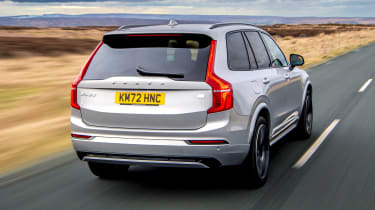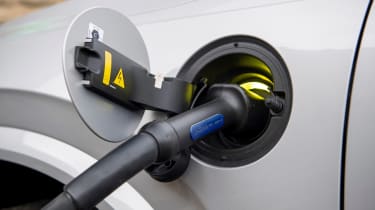Volvo XC90 review - MPG, CO2 and running costs
Mild-hybrid diesel tech offers good economy, but the XC90 Recharge plug-in hybrid is the most efficient model in the range

Volvo quotes WLTP-tested fuel economy of up to 39.7mpg for the B5 mild-hybrid diesel engine. This is poorer than the 49.6mpg quoted for the old D5, but is a reflection on the tougher test conditions now faced, and means you're more likely to achieve this figure in everyday driving. Elsewhere, the B5 petrol has a combined figure of up to 32.4mpg and more powerful B6 petrol will return up to 30mpg, according to Volvo.
The XC90 Recharge will be a favourite among company car users – its plug-in hybrid tech allowing it to return up to 235.1mpg in WLTP testing. In reality, the plug-in XC90 will get nowhere near its claimed fuel economy, especially if you spend a lot of time on motorways as we discovered first hand.
On one 90-mile journey that involved a mixture of dual carriageways and country roads we achieved about 43mpg, and going about double that distance mostly on motorways saw us achieve an even less impressive 34mpg. Neither figure is that surprising though as once the T8’s 18.8kWh battery is depleted, the XC90 becomes a 2.3-tonne SUV almost exclusively powered by a turbocharged and supercharged four-cylinder petrol engine.
Of course, the XC90 PHEV makes up for that with its significantly lower CO2 emissions ratings – 28-34g/km versus over 200g/km for the mild-hybrid variants. As a result it attracts a lower Benefit-in-Kind (BiK) tax rate of just 8 per cent compared to the 37 per cent band the rest of the range lands in, meaning 40 per cent tax payers will need to fork over a smidge under £2,300 a year to drive the T8 or £9,000 or more if they stick with the mild-hybrids.
Electric range, battery life and charge time
The plug-in hybrid XC90 originally used an 11.6kWh battery pack, but the updated model comes with an 18.8kWh unit that has boosted the car’s official electric-only driving range from 27 miles to a slightly more impressive 40 miles. That’s still not as far as plug-in hybrid versions of the Mercedes GLE, BMW X5 or Range Rover Sport will go without using any petrol, and in reality you’re more likely to get close to 30 miles of range from a full charge. Although that’s not an issue exclusive to the XC90 PHEV. In any case, you’ve got enough juice to cover a reasonable-length commute and an even longer one for those able to charge at work.
More reviews
Car group tests
- Genesis GV80 vs Volvo XC90: 2021 group test review
- Lexus RX vs Volvo XC90
- Mercedes GLE vs Volvo XC90
- Lexus RX L vs Volvo XC90
- Audi Q7 e-tron vs Volvo XC90 T8
In-depth reviews
Road tests
Used car tests
On the subject of charging T8 owners no longer have to make do with a below-average 3.7kW maximum speed. The updated model can charge at up to 6.4kW, meaning you can fully charge the larger battery from empty in around five hours using a standard 7.4kW home wallbox or public charging point.
Insurance groups
A wide range of passive and active safety and security technologies has helped to ensure that insurance costs are reasonably competitive for the Volvo XC90 compared to close rivals. The B5 diesel in Plus trim sits in group 42 (out of 50), while the petrol version is in group 41 (the Audi Q7 falls into groups 42-49).
The plug-in hybrid versions have slightly higher insurance ratings than the conventional models, with a top-spec XC90 Recharge in Ultimate trim getting a group 45 rating.
Depreciation
The old XC90 proved to be quite stubborn in holding on to its value, although the latest model is only reasonable in this regard. Our expert data suggests that the XC90 should hold onto around 54 per cent of its original value over an average ownership period of three-years and 36,000-miles. In comparison, the Audi Q7 is predicted to retain up to 64 per cent over the same period.
Which Is Best
Cheapest
- Name2.0 D5 Momentum 5dr AWD Geartronic
- Gearbox typeSemi-auto
- Price£45,500
Most Economical
- Name2.0 T8 [455] RC PHEV Inscription Expr 5dr AWD Auto
- Gearbox typeSemi-auto
- Price£66,325
Fastest
- Name2.0 T8 [455] RC PHEV Inscription Expr 5dr AWD Auto
- Gearbox typeSemi-auto
- Price£66,325






